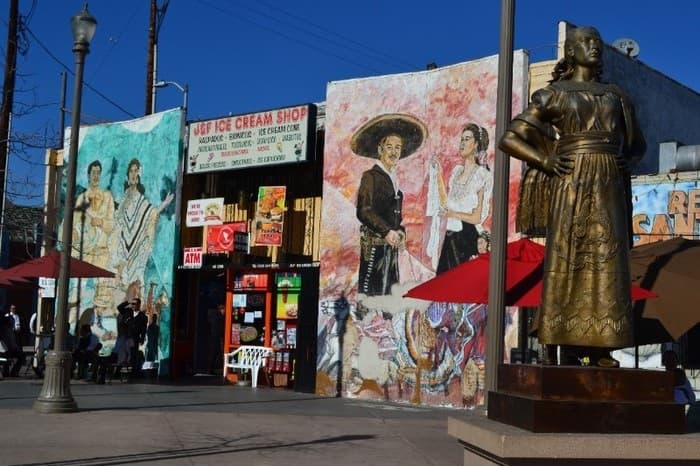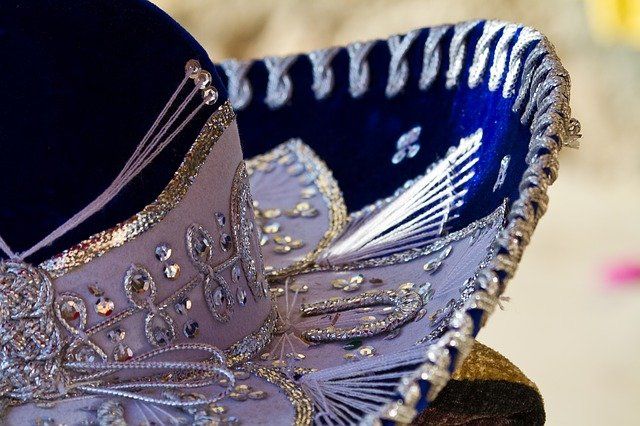Mariachi Plaza, Mexico's beating heart in Los Angeles
Over the decades, Mariachi Plaza has been a symbol of the Chicano community in California and has served as a bridge between Mexico and the United States.

Before the pandemic, dozens of Los Angeles musicians gathered at Mariachi Plaza, the meeting place of the Latin quarter Boyle Heights and the emblem for the "Chicanos" of the Californian city that for decades has served as a bridge between Mexico and the United States.
Any normal midday in this corner of East Los Angeles, singers, trumpeters, and guitarists would be wearing regional costumes while waiting to be hired for some show or surprise; now, the virus has paralyzed that image, but life in the second most populous city in the country continues with the rhythm of its music.
In a metropolitan area of more than 12 million people, extremely diverse and where almost 50% identify themselves as "Latino or Hispanic," there are neighborhoods like this one where the last census estimated that percentage to be 90%. And the vast majority of them are from or have roots in Mexico.
Taquerías, cantinas, sports shops with images of football players and wrestlers... are commonplace in Los Angeles, less media-friendly than the photographs of Beverly Hills or Hollywood - and all the mythology that goes with them - but also very representative of the reality of the United States.
"I was born in Mexico but have always lived here since I was a child. My parents lived here, I've grown up, I got married and I have my job here," she tells Efe Minerva in perfect Spanish. In this area, the complicated thing is to find someone who doesn't speak the language.
Feet in the U.S., eyes in Mexico
Minerva runs a business with her husband where she sells horchata, fresh water, ice cream, toast, and other dishes. Before the coronavirus, mariachis were the usual clientele of this place located in front of the traditional "kiosk" -stage- that the Mexican state of Jalisco donated in 1998 so that the Mariachi Plaza that looks at the skyscrapers of downtown Angelino would join the mythical Plaza Garibaldi in Mexico City.
"The musicians were 60 percent of my clients and now there are no celebrations, they don't work and they don't come," she says. Concern about the coronavirus, which is especially strong in California, is spreading from here to Mexico, a country with enormous difficulties in containing contagion and the impact it has had on the economy.
"I follow the news from Mexico and watch the Spanish-language channels," says Minerva, who laughs when she says that she follows "the soap operas" from Mexico in particular, but is interested in the situation there, "where many didn't believe" in the seriousness of the disease. The U.S. Latino population has multiplied more than six times since 1970 and last year passed the 60.6 million mark, but its growth has slowed.
She and the rest of her clients are well aware of Mexican President Andres Manuel Lopez Obrador's visit to the White House this week. The date of the meeting between Trump and Lopez Obrador is marked on the calendar by Pedro Prieto, the head of the family sporting goods store. "It's the 8th, right?" he asks, and the answer is given.
The "Chicano" culture over generations
In Prieto's shop, football is predominant, equipment and team photos are hanging on the walls while the television broadcasts the match of Sevilla FC against Eibar in the Spanish league. "I was born here in the United States, my parents are Mexican, they started the business in 1974 and now my sister and I run it," he says.
Like many "Chicanos" - a term that defines Americans of Mexican descent - Prieto, who lived in Mexico for 12 years and returned to Los Angeles, feels a sense of both countries. "I'm proud to have been born in the United States, and I'm proud of Mexico and my family," he says. The activity of his sports shop is a perfect example of the coexistence of these two cultures, with soccer and baseball as star sports.
The Bureau of Labor Statistics reported a total of 4.8 million jobs generated and the unemployment figure fell to 11.1%, compared to 13.3% the previous month. "When my parents started the business, the first 20 years were almost 90% soccer and the last 20 have been more towards baseball," recalls Prieto, who follows "political and sports information in Mexico.
The restaurants surrounding the store are repeating the merger of the two countries, some with signs advertising tacos, pastrami, and hamburgers, or bars broadcasting Spanish and Latin American soccer games, as well as NBA games.
The challenge of staying authentic
But for some years now there has been a theme occupying the conversations in Boyle Heights: gentrification, the process by which the population of a neighborhood is displaced by people from a higher economic level. This movement is especially aggressive in a city like Los Angeles, where a combination of real estate speculation, market bubbles, and changing trends can activate and degrade whole neighborhoods in the blink of an eye.

With the arrival of the subway and the absence of gangs, investors put their focus on this Latino enclave and the rents of many families settled for generations began to skyrocket. But the sense of community united the neighbors, who have managed to pause the process with actions that range from promoting rent control - applied in many areas of California - although without avoiding conflicts with new businesses that seek to attract hipster clientele.
The struggle was so powerful that Netflix and America Ferrera took notice and created the series "Gentefied," which focuses on the life of a Latino family that owns a modest restaurant in Boyle Heights, a neighborhood as American as it is Mexican, at least in the soul.




